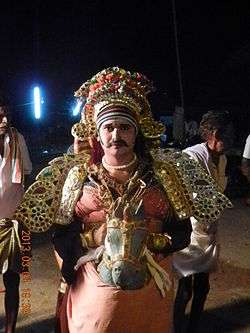Poikkaal Kuthirai Aattam
Poikkaal Kuthirai Aattam (poi - False, kaal - leg, Kuthirai – Horse) or Puravi Aattam (Tamil:பொய்க்கால்குதிரை ஆட்டம்) (Dummy Horse Dance) is one of the folk dances of Tamil Nadu. It is a type of dance performed with a dummy horse having a gap inside so that a person can fit into it to perform the dance.

Materials
The dummy figure of a horse's body is made of light-weighted materials (jute, cardboard, paper, and glass) and the cloth at the sides of the dummy swings to and fro covering the legs of the dancer.[1][2] The dancers tie wooden legs to their feet so that sound is evoked when they are tapped on the floor, which sound like the hooves of the horse. The dancer brandishes either a sword or a whip.
Performers
This folk dance needs much training and skill to perform.[3] The show is performed by men as well as women. This artistic performance is generally arranged during religious festivals and provides entertainment to the masses.
Background music
This dance is rendered to the accompaniment of music such as clarionet, drum, south Indian folk dance instruments such as Kundalam, Naiyaandi Melam, Thavil, Nadhaswaram, Pambai and Thalam.[4]
Performance
This artistic performance is connected to the worship of Ayyanar and prevails mainly around Thanjavur. This dance is performed by a pair of dancers impersonating a king and queen. Sometimes, they indulge in acrobatics and they entertain the folk for hours together. The dummy-horse show is one of the main attractions in the republic day festivities at New Delhi and folk artists are sent from Tamil Nadu every year to perform this show.[5]
Alternate view
Recent research on poikaal Kuthirai dance dispelled the myth that this art is ancient and of Maratha origin.[6]
References
- "South india travel agents,music,dance,mumbai,delhi,kerala,chennai,goa,karnataka". Retrieved 30 June 2015.
- "Puravai Attam-Art of Tamil Nadu-dance of Tamil Nadu-karakam dance-puravali attam-arayar natanam-podikazhi attam". Retrieved 30 June 2015.
- "Tamil Nadu Traditional, Cultural&Educational Trust". Archived from the original on 21 February 2015. Retrieved 30 June 2015.
- "::Welcome to Thanjavore Folk Dances::Video Gallery". Retrieved 30 June 2015.
- Prakash Talwar, "Travel and Tourism Management", Isha Books, Delhi, 2006. pp.134
- Krishnamachari, Suganthy (25 March 2010). "Dances with a past". The Hindu. Retrieved 15 July 2020.
| Tamilian Dance Forms | edit |
|---|---|
| Amman Koothu | Annakodi Vizhaakkooththu | Anuman Aattam | Aali Aattam | Irular Inamakkalin Aattam | Ilavani | Ekkaalak Koothu | Oyilattam | Karakattam | Karadiyattam | Kazhiyalaattam | Kaniyaan Koothu | Kaavadiyaattam | Kuravan Kuraththi Aattam | Kuravai, Thunangai, Thazuvu - Aattangal | Konangiyaattam | Kokkalikattai Aattam | Kolaattam | Kummiyaattam | Sakkai Kuchchi Aattam | Sakkaiyaattam | Salangaiyaattam | Silambattam | Sevaiattam | Thudumbaattam |Therukkooththu | Thevaraattam | Bharata Natyam | Paraimelak Koothu | Paraiyattam | PaavaikKoothu | Paampu attam | Periyamelam | Puliyattam | Bommalaattam | Poikkaal Kuthirai Aattam | Magudik Koothu | Mayilattam | Marakkaalaattam | Maadattam | Raja Rani Aattam | Jikkaattam | |